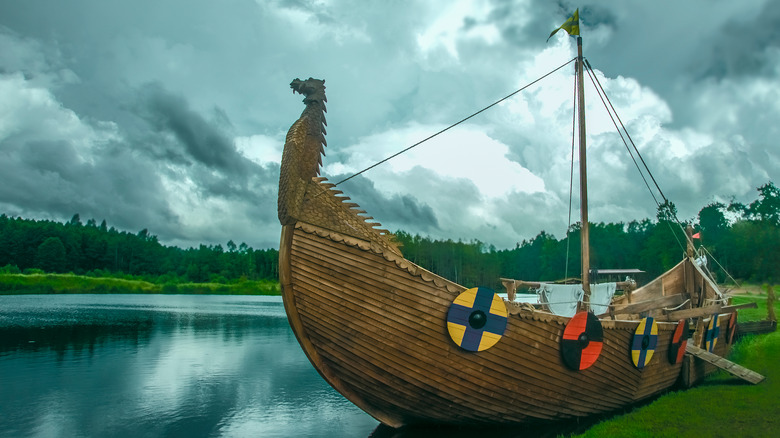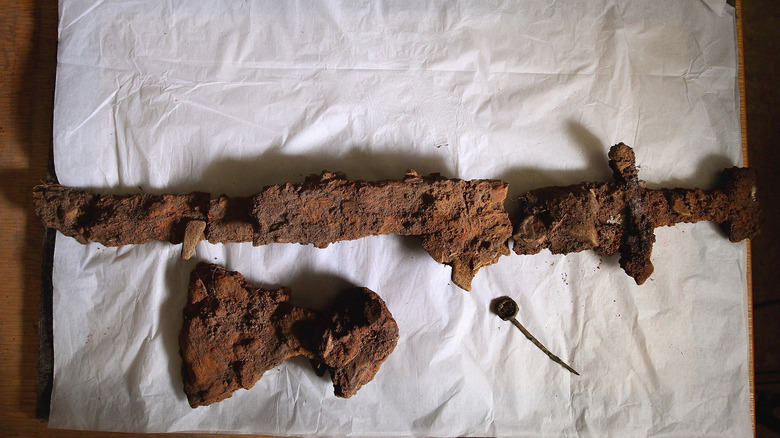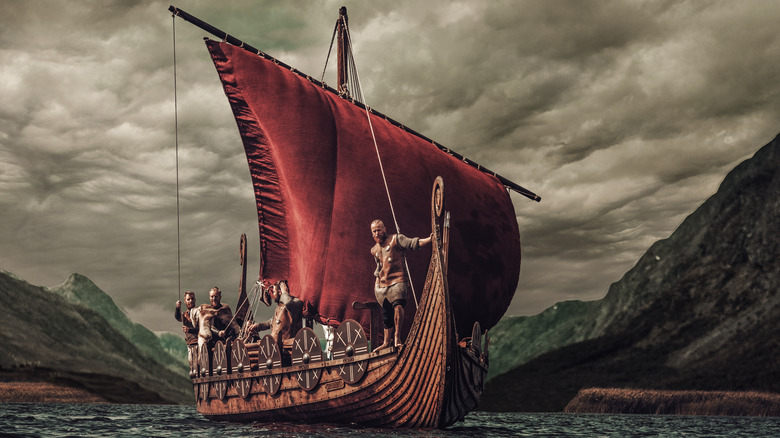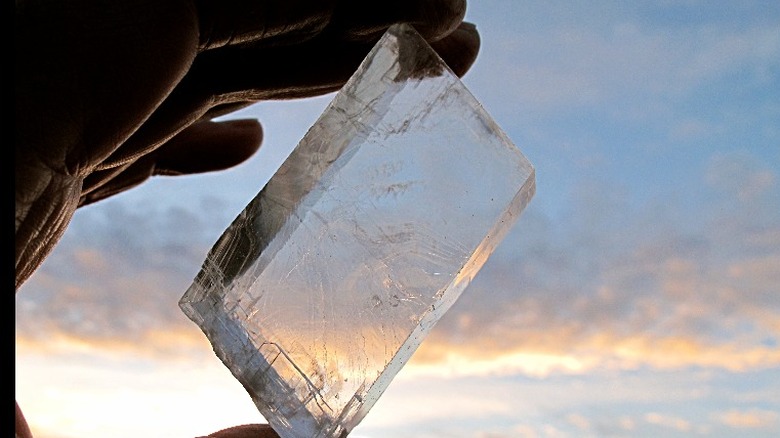What You Didn't Know About The Vikings' Unique Compass
Vikings were quite the travelers. From the 8th to 11th centuries, they journeyed throughout Europe, the North Atlantic, and to North America, exploring, trading, and plundering villages along the way, according to the BBC. Part of their success came from the technology they used. For instance, their ships were "designed for speed, to carry the maximum number of men, and to go a fair way up river systems," Davy Cooper of the Shetland Amenity Trust told the BBC. "The shape of the boat meant it created bubbles on the edge of the planks. To all intents and purposes, a Viking ship rides on a cushion of air, and has far less resistance in water." It also meant that their ships didn't require deep water to move about.
The Vikings built many types of boats, like their longships (in above photo), used for raiding and warfare, with the front of it featuring a carved dragon, snake or another fierce animal to intimidate their foes, said Royal Museums Greenwich. They also had cargo vessels for trading, filled with items from their Scandinavian home — furs, walrus ivory, and amber. All vessels moved either by the wind filling their sails or through the efforts of Vikings rowing.
A special compass might have guided vikings
The weapons the Vikings carried also helped ensure their success during wars and raids. While primitive — bows and arrows, lances, spears, swords, and axes (see photo above of blade and axe head) — their equipment enabled them to be fierce fighters, said The National Museum of Denmark. They also adopted various protection devices, like shields, helmets, and chain mail. What you carried depended on economic status. Axes and lances went to the less wealthy warriors, for example, while sword carriers experienced lives of affluence. Few Viking helmets and chain mail survive today, so experts believe less of these were available, reserved for the more moneyed Vikings.
No matter why the Vikings traveled — warfare, exploration, trade, plundering, or other pursuits — they didn't use maps. They had other ways of navigating. Vikings relied on more natural means than technological to find the locations they wanted. They watched animals like birds and whales to help decide their directions, said Science Nordic, since these creatures were often found only in certain areas. The Vikings also used the sun, the moon, and landmarks to determine their path was correct. "Back then, there were of course no compasses, echo sounders, satellite navigation or radio communication," Dr. Anton Englert, who researches into Viking Age seafaring at the Viking Ship Museum in Roskilde, Denmark, told Science Nordic.
Well, nothing modern-day society would consider a compass ... but the Vikings did have had a little help.
Exploring the globe by getting lost
The Vikings did have access to a special "sun compass," really a circle with a pin in the center, which they used to find areas based on the sun's position. The method proved less than perfect. "They tended to get blown places accidentally, but they knew what direction to sail going back," explained Cooper to the BBC. "That meant they could find the place again, and they could tell someone else how to find it."
The exact design of this "compass" is unknown, but it is hypothesized that it was used in conjunction with other objects such as a wooden slat, according to Live Science. Allegedly, the mariners could use a combination of items to navigate in less than ideal conditions. "When the sun is low above the horizon, even the shadow of a small item can fall off the board, and such situations are frequent in the northern seas," said Balázs Bernáth, co-author of a study about the compass from researchers at Eötvös Loránd University in Hungary. The other tools possibly maximized the power of the compass.
A mysterious crystal or two
A luminous mineral was also possibly combined with this simple sun compass. "They used a crystal that, when turned in a certain direction it goes dark, and when it goes in another direction it goes light," said Cooper to the BBC. "So when turned to a light source they discovered that it even worked in fog if they knew where the sun was — meaning they could figure out what direction they were traveling in."
Some researchers believe one such sun compass, called the Uunartoq disc, was discovered in Greenland, said Live Science. They believe a pair of crystals, also known as sunstones, could have created patterns that guided the Vikings up to 50 minutes past sunset. While Viking stories talk about such special crystals, no archaeological dig has ever discovered one, although History on the Net does point out that such an item was found in a shipwreck by the Channel Islands. The item was pegged as an Icelandic spar ... but, maybe, it's the fabled sunstone?



